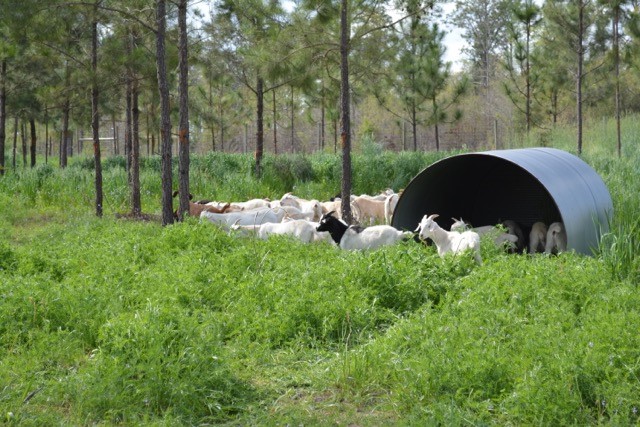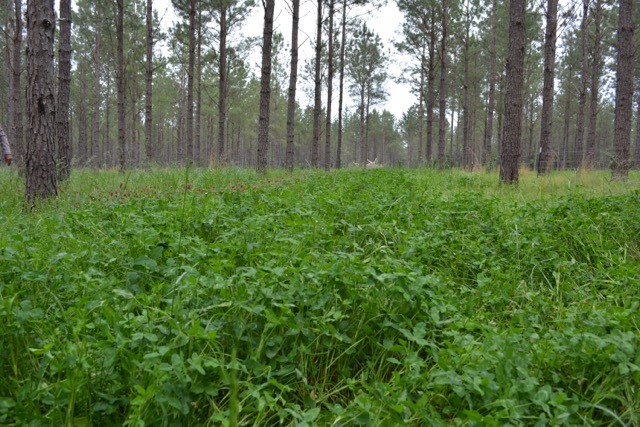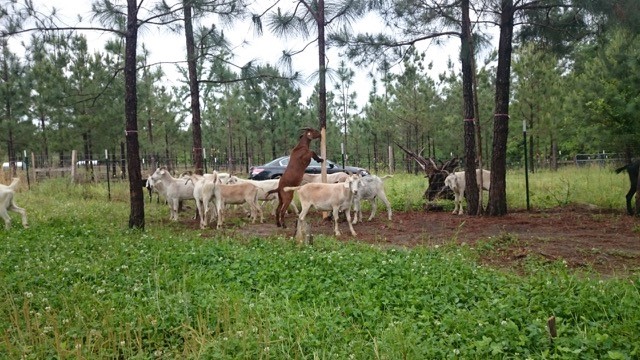Silvopasture is a sustainable agroforestry practice where trees and forages are grown together in a single management unit, and grazing livestock are incorporated into this unit to utilize the available forages. A silvopasture system can be developed by thinning down existing woodlands, and establishing and managing suitable forage species in the remaining available space. As most small-scale livestock producers in the Southeast have limited acreage of open pasture, but have several acres of woodland, there is a tremendous potential to develop silvopasture systems to extend and expand grazing opportunities. To successfully develop and manage silvopasture systems, information is needed on suitable forages. Experts at Tuskegee University evaluated eight different cool-season forages for goats at two different sites.

Site 1 is located near the Tuskegee University Campus in Tuskegee, Alabama. This silvopasture plot consisted of longleaf-loblolly mixed pine in loamy sand soil (Figure 1). In total, there are three 1-acre plots at site 1 with 11-12 year old trees. Eight different cool-season forages -annual ryegrass (Marshall), arrowleaf clover, chicory, crimson clover, hairy vetch, MaxQ tall fescue, rye, and white clover- were cultivated in separate strips within each plot in fall of 2014 and 2015. When forages were well established and attained the recommended grazing height, Kiko wethers goats were rotationally stocked in the plots based on the available forage biomass. Grazing started in early spring of 2015 and in early winter of 2016, and ended around mid-May. Goats grazed all forages well from the start, with the exception of white clover, which was grazed moderately towards the later portion of the grazing season.

Site 2 is located in Planterville, Alabama. This silvopasture plot consisted of 14 acres of 18-19 year old loblolly pines in fine sandy loam soil. The plot was subdivided into four paddocks after a second thinning (Figure 2). In fall of 2015, a combination of Marshall ryegrass and crimson clover was grown in two plots, while MaxQ tall fescue and arrowleaf clover w ere grown in the remaining two plots. Grazing began in January of 2016 with a mixed breed of goats, and continued until the end of June. Goats readily grazed all of the forages from the start. Additional work is continuing to evaluate warm-season forages in these sites.
Goats showed some debarking behavior while grazing in Site 1, especially on longleaf pines, resulting in the death of the heavily debarked trees (Figure 3). Studies to identify alternative grazing animals in order to minimize tree damage at this site are underway. Goats in Site 2 did not show any debarking behavior. These studies showed the potential of expanding grazing opportunities for animals by developing silvopasture systems after thinning southern-pine plantations. Any of the cool-season forages evaluated in these studies or a combination of these forages suitable to the soil type and climatic condition can be grown for developing cool-season grazing. However, the grazing manager needs to be watchful for damage the grazing animals may inflict on trees, and take appropriate action to avoid it.

